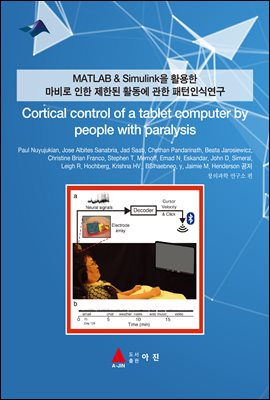
MATLAB & Simulink을 활용한 마비로 인한 제한된 활동에 관한 패턴인식연구(Cortical control of a tablet computer by people with
- 저자Paul Nuyujukian, Jose Albites Sanabria, Jad Saab, Chethan Pandarinath, Beata Jarosiewicz 저
- 출판사아진
- 출판일2020-07-14
- 등록일2020-12-21
- SNS공유


- 파일포맷PDF
- 파일크기7MB
- 공급사YES24
-
지원기기
PC
PHONE
TABLET
프로그램 수동설치
전자책 프로그램 수동설치 안내
아이폰, 아이패드, 안드로이드폰, 태블릿,
보유 1, 대출 0,
예약 0, 누적대출 8, 누적예약 0
책소개
General-purpose computers have become ubiquitous and important for everydaylife, but they are difficult for people with paralysis to use. Specialized software
and personalized input devices can improve access, but often provide only limited
functionality. In this study, three research participants with tetraplegia who had
multielectrode arrays implanted in motor cortex as part of the BrainGate2 clinical
trial used an intracortical brain-computer interface (iBCI) to control an unmodified
commercial tablet computer. Neural activity was decoded in real time as a
point-and-click wireless Bluetooth mouse, allowing participants to use common
and recreational applications (web browsing, email, chatting, playing music on a
piano application, sending text messages, etc.). Two of the participants also used
the iBCI to “chat” with each other in real time. This study demonstrates, for the
first time, highperformance iBCI control of an unmodified, commercially available,
general-purpose mobile computing device by people with tetraplegia.
목차
제 1편 : SIMULINK 기본편1.1 SIMULINK의 시작 1
블록의 연결 5
블록 파라미터의 설정 7
시뮬레이션 파라미터 (Configuration Parameters)의 설정 8
시뮬레이션의 수행 9
블록 파라미터의 표시 9
복수 데이터의 표시 11
2.2 동적 시뮬레이션 13
이차 미분방정식 17
선형 상태변수 모델 23
DC 모터의 시뮬레이션 24
함수 블록의 사용 29
차분방정식(difference equation)의 모델링 34
Subsystem(부시스템)의 구성 37
제 2편 : 연구논문
Cortical control of a tablet computer by people with
paralysis
1. Introduction 42
2. Materials and methods 42
3. Neural decoders 43
4. Results 45
5. Discussion 49
6. Conclusion 52
7. References 54

















